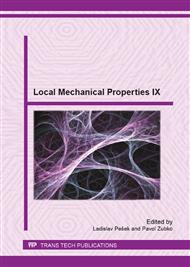p.162
p.166
p.170
p.174
p.178
p.182
p.186
p.190
p.194
Mechanical Properties of Interface of Heterogeneous Diffusion Welds of Titanium and Austenitic Steel
Abstract:
Titanium is material which is used in many areas of human activity. Therefore it is necessary to join it with other material. It is very difficult to welding Ti with other metals by conventional fusion welding methods. There exist special joining technologies of heterogeneous materials which is possible to use. This is usually a joining of materials in the solid state, as diffusion welding, friction welding or explosion welding. This contribution deals with diffusion welding of titanium alloy Ti6Al4V and stainless austenitic steel 1.4301. There are described mechanical properties (as is reduced modulus Er and indentation hardness HIT) and changes of chemical composition of join due to diffusion of elements.
Info:
Periodical:
Pages:
178-181
Citation:
Online since:
September 2013
Authors:
Price:
Сopyright:
© 2014 Trans Tech Publications Ltd. All Rights Reserved
Share:
Citation:


